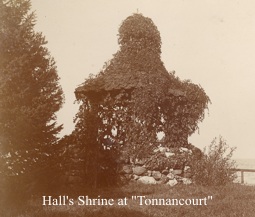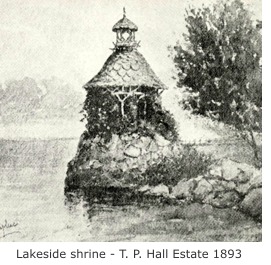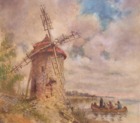A Legend of the "Coureur des Bois", French trappers Long before Cadillac founded Detroit, certain courageous woodsmen called "coureurs des bois", pitched their tents on the shores of Lake St. Clair. Among them was Jean Parent, whose stern, silent face like a tombstone seemed to hide the dust of dead and buried hopes. He left the graves of his wife, parents and family beneath Canada's skies.
One tender roolet remained to try to win him back to life - little Genevieve, his daughter. He had brought her with him to Grosse Pointe, and her happy, sunny disposition gave him great joy. As Jean gazed upon his growing child he would smile, as if some bygone memory came back to surprise his heart. An expression of gentleness would flash on his face, and his voice would soften like the winds after a storm. Others soon came to know his little forest flower, Genevieve, and simply adored her. Shyly, she turned away from them; the wings of her heart were still furled. As she grew older Genevieve became anxious to devote her life to the service of God. So she wrote to her aunt, the Mother Superior, at the convent at Three Rivers, asking to be admitted as a nun. 
One day a young man, Jacques Morand, met Genevieve, and he was charmed by her as if he had seen a vision. Jacques was one of fifty men who had come with the explorer Duluth in 1680 to found Fort St. Joseph. Genevieve tried gently to make Jacques Morand understand that his affection for her was not wanted. She tried to explain to him that her heart was set on becoming a nun. This certainty on her part only inflamed his wish to love her either by fair or foul means.
In his desperation, Jacques asked for help from an old Indian witch who practiced her spells in the darkest part of the forest. Jacques made a deal with the indian woman and promised to sell his soul to the devil. In exchange, the witch gave Jacques the power to change himself into a werewolf, or a "Loup Garou", so he could carry poor Genevieve away. The mail delivery of those primitive days was not as fast or reliable as it is today, so Genevieve waited a long time for an answer to arrive from the Mother Superior at Three Rivers convent.
Genevieve spent most of her time preparing herself for her new career by praying and fasting. Genevieve prayed at an alter to Notre Dame de Bonsecour on the edge of the forest beneath an ancient oak tree. But Genevieve wished to build a new alter at the beach. So, assisted by her father, she found one of the rocks cast there by some great Manitou, and placed upon it a statue of the Blessed Virgin Mary. She frequently visited the new altar, spending long hours at the beach. The waves would sing lazily as they crept upon the shore, and the birds would catch the tune and chant it to the rustling leaves. It was early in the springtime when the earth blossomed with new hopes, that Genevieve sent her request to Three Rivers. And not until late in the fall, when the waters chased by the east wind had nestled at the foot of the rocky altar, that the answer came to Genevieve that her wish was granted. With a heart bursting with happiness, she ran through the autumn leaves to visit the forest altar of Bonsecour and pour forth her simple thanks.
 As she approached the beach, Jacques, in the form of a Loup Garou, with gleaming eyes, sprang out into her path. But the cross which she held in her hand dazed him. Like a fawn, Genevieve leaped aside and flew swifter than the wind toward the lake. The evil beast came bounding in hot pursuit. Genevieve, finding her strength failing sought shelter in the little grotto of rocks on the beach. She threw herself at the feet of the Virgin Mary, begging for help. She felt the fiery breath of the beast and, with a terrified cry for mercy, fainted. Her cry was heard because as the Loup Garou leaped on the rocks he was instantly transformed to stone. His grinning evil face, frozen in granite, can still be seen on the beach there today. Those who drive by the Lake Shore Drive today merely see a pretty harbor, but the descendants of the old French habitants say, "Voila le Garou!"
As she approached the beach, Jacques, in the form of a Loup Garou, with gleaming eyes, sprang out into her path. But the cross which she held in her hand dazed him. Like a fawn, Genevieve leaped aside and flew swifter than the wind toward the lake. The evil beast came bounding in hot pursuit. Genevieve, finding her strength failing sought shelter in the little grotto of rocks on the beach. She threw herself at the feet of the Virgin Mary, begging for help. She felt the fiery breath of the beast and, with a terrified cry for mercy, fainted. Her cry was heard because as the Loup Garou leaped on the rocks he was instantly transformed to stone. His grinning evil face, frozen in granite, can still be seen on the beach there today. Those who drive by the Lake Shore Drive today merely see a pretty harbor, but the descendants of the old French habitants say, "Voila le Garou!"



